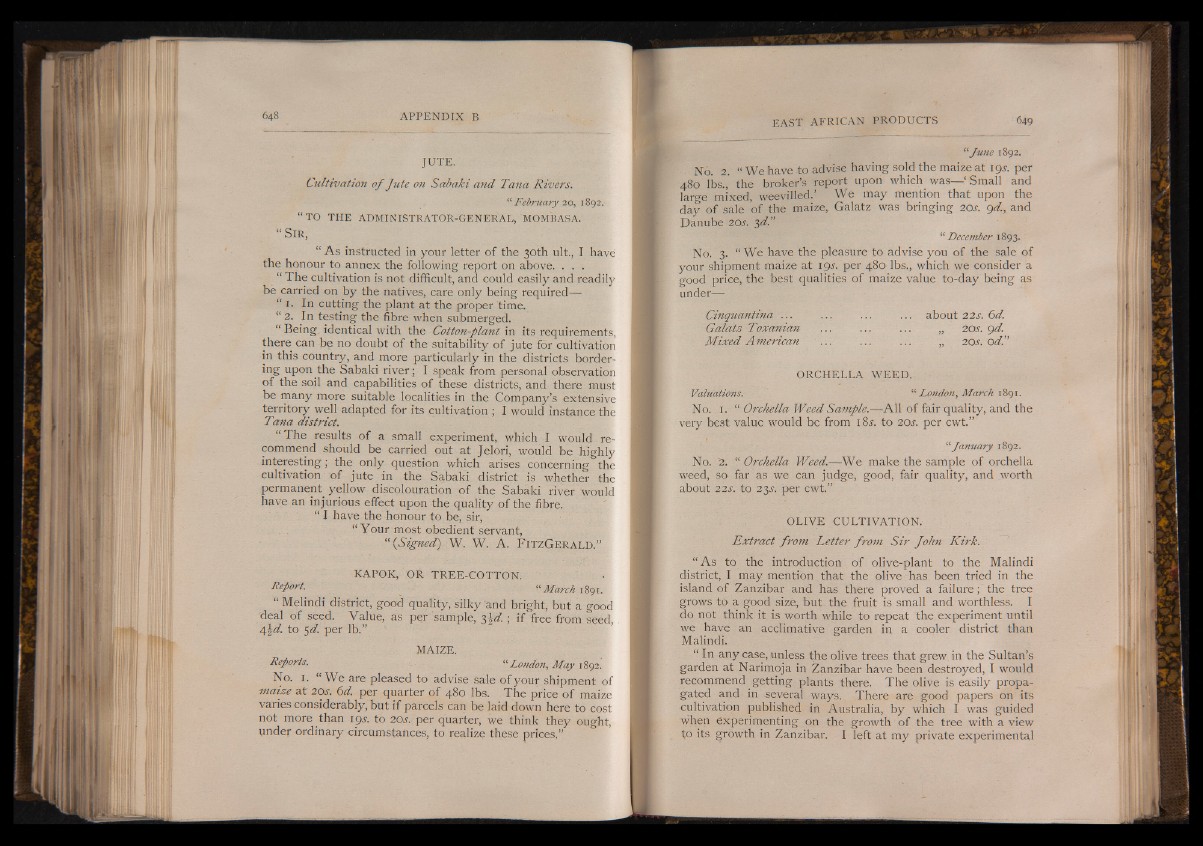
JUTE.
Cultivation o f Jute on Sabaki and Tana Rivers.
“ February 20, 1892.
“ TO THE ADMINISTRATOR-GENERAL, MOMBASA.
“ S ir ,
“ As instructed in your letter of the 30th ult., I have
the honour to annex the following report on above. . . .
“ The cultivation is not difficult, and could easily and readily
be carried on by the natives, care only being required—
“ 1. In cutting the plant at the proper time.
“ 2. In testing the fibre when submerged.
“ Being identical with the Cotton-plant in its requirements,
there can be no doubt of the suitability of jute for cultivation
in this country, and more particularly in the districts bordering
upon the Sabaki river; I speak from personal observation
of the soil and capabilities of these districts, and there must
be many more suitable localities in the Company’s extensive
territory well adapted for its cultivation ; I would instance the
Tana district.
“ The results of a small experiment, which I would recommend
should be carried out at Jelori, would be highly
interesting; the only question which arises concerning the
cultivation of jute in the Sabaki district is whether the
permanent yellow discolouration of the Sabaki river would
have an injurious effect upon the quality of the fibre.
“ I have the honour to be, sir,
“ Your most obedient servant,
“ (Signed) W. W. A. F it zG e r a ld .”
KAPOK, OR TREE-COTTON.
Report. “ March 1891.
“ Melindi district, good quality, silky ‘and bright, but a good
deal of seed. Value, as per sample, 3\d .; if free from seed,
4\d. to 5d. per lb.”
MAIZE.
Reports. ... “ London, May 1892.
No. 1. “ We are pleased to advise sale of your shipment of
maize a t 2os. 6d. per quarter of 480 lbs. The price of maize
varies considerably, but if parcels can be laid down here to cost
not more than 19s. to 20s. per quarter, we think they ought,
under ordinary circumstances, to realize these prices,”
“ June 1892.
No. 2. “ We have to advise having sold the maize at 19s. per
480 lbs., the broker’s report upon which was— ‘ Small and
large mixed, weevilled.’ We may mention that upon the
day of sale of the maize, Galatz was bringing 20s. gd., and
Danube 20s. 3d.”
“ December 1893.
No. 3. “We have the pleasure to advise you of the sale of
your shipment maize at 19s. per 480 lbs., which we consider a
good price, the best qualities of maize value to-day being as
under—
Cinquantina ... ... ... ... about 22s. 6d.
Galatz Toxanian ... ... ... „ 20s. 9d.
Mixed American ... ... ... „ 20s. od.”
ORCHELLA WEED.
Valuations. “ London, March 1891.
No., 1. “ Orchella Weed Sample.— All of fair quality, and the
very best value would be from i8r. to 20s. per cwt.”
“ January 1892.
No. 2. “ Orchella Weed.— We make the sample of orchella
weed, so far as we can judge, good, fair quality, and worth
about 22s. to 23-r. per cwt.”
OLIVE CULTIVATION.
Extract from Letter from S ir John Kirk.
“ A s to the introduction of olive-plant to the Malindi
district, I may mention that the olive has been tried in the
island of Zanzibar and has there proved a failure; the tree
grows to a good size, but the fruit is small and worthless. I
do not think it is worth while to repeat the experiment until
we have an acclimative garden in a cooler district than
Malindi.
“ In any case, unless the olive trees that grew in the Sultan’s
garden at Narimoja in Zanzibar have been destroyed, I would
recommend getting plants there. The olive is easily propagated
and in .several ways. There are good papers on its
cultivation published in Australia, by which I was guided
when experimenting on the growth of the tree with a view
to its growth in Zanzibar. I left at my private experimental